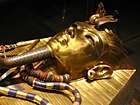Tiye
Tiye (c. 1398 BC – 1338 BC, also spelled Tye, Taia, Tiy and Tiyi) was the daughter of Yuya and Tjuyu. She became the Great Royal Wife of the Egyptian pharaoh Amenhotep III. She was the mother of Akhenaten and grandmother of Tutankhamun. In 2010, DNA analysis confirmed her as the mummy known as "The Elder Lady" found in the tomb of Amenhotep II (KV35) in 1898.
| Tiye | |||||||
|---|---|---|---|---|---|---|---|
 Bust of Tiye, now in the Ägyptisches Museum in Berlin, Germany | |||||||
| Queen consort of Egypt | |||||||
| Tenure | c. 1390 BC – 1353 BC (37 years) | ||||||
| Born | c. 1398 BC Akhmim, Upper Egypt | ||||||
| Died | 1338 BC (aged 60 years) | ||||||
| Burial | |||||||
| Spouse | Amenhotep III | ||||||
| Issue | Sitamun Iset Henuttaneb Nebetah Thutmose Akhenaten Smenkhkare (possibly) "The Younger Lady" Beketaten | ||||||
| Egyptian name | |||||||
| Dynasty | 18th of Egypt | ||||||
| Father | Yuya | ||||||
| Mother | Tjuyu | ||||||
| Religion | Ancient Egyptian religion | ||||||
Family and early life
Tiye's father, Yuya, was a non-royal, wealthy landowner from the Upper Egyptian town of Akhmim,[1] where he served as a priest and superintendent of oxen or commander of the chariotry.[2] Tiye's mother, Tjuyu, was involved in many religious cults, as her different titles attested (Singer of Hathor, Chief of the Entertainers of both Amun and Min...),[3] which suggests that she was a member of the royal family.
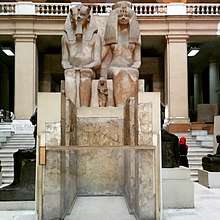
Egyptologists have suggested that Tiye's father, Yuya, was of foreign origin due to the features of his mummy and the many different spellings of his name, which might imply it was a non-Egyptian name in origin.[4] Some suggest that the queen's strong political and unconventional religious views might have been due not just to a strong character, but to foreign descent.[3]
Tiye also had a brother, Anen, who was Second Prophet of Amun.[5] Ay, a successor of Tutankhamun as pharaoh after the latter's death, is believed to be yet another brother of Tiye, despite no clear date or monument confirming a link between the two. Egyptologists presume this connection from Ay's origins (also from Akhmin), because he is known to have built a chapel dedicated to the local god Min there, and because he inherited most of the titles that Tiye's father, Yuya, held at the court of Amenhotep III during his lifetime.[3][6]
Tiye was married to Amenhotep III by the second year of his reign. He had been born of a secondary wife of his father and needed a stronger tie to the royal lineage.[4] He appears to have been crowned while still a child, perhaps between the ages of six and twelve. The couple had at least seven, and possibly more, children:
- Sitamun – The eldest daughter, who was elevated to the position of Great Royal Wife around year 30 of her father's reign.[7]
- Isis – Also elevated to the position of Great Royal Wife.[7]
- Henuttaneb – Not known to have been elevated to queenship, though her name does appear in a cartouche at least once.
- Nebetah – Sometimes thought to have been renamed Baketaten during her brother's reign.
- Crown Prince Thutmose – Crown Prince and High Priest of Ptah, pre-deceasing his father.
- Amenhotep IV/Akhenaten – Succeeded his father as pharaoh, husband of Queen Nefertiti, father of Ankhesenamun, who married Tutankhamun.
- Smenkhkare – traditionally seen as one of Akhenaten's immediate successors, today some Egyptologists such as Aidan Dodson believe he was the immediate predecessor of Neferneferuaten and a junior co-regent of Akhenaten who did not have an independent reign.[8] Sometimes identified with the mummy from KV55, and therefore Tutankhamun's father.
- The Younger Lady from KV35 – A daughter of Amenhotep III and Tiye, mother of Tutankhamun and sister-wife of KV55. Presumably one of the already-known daughters of Amenhotep III and Tiye.
- Beketaten – Sometimes thought to be Queen Tiye's daughter, usually based on reliefs of Baketaten seated next to Tiye at dinner with Akhenaten and Nefertiti.[1]
Monuments
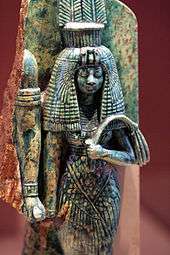
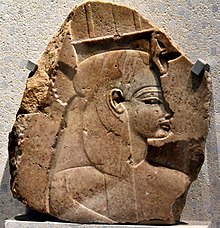
Her husband devoted a number of shrines to her and constructed a temple dedicated to her in Sedeinga in Nubia where she was worshipped as a form of the goddess Hathor-Tefnut.[9] He also had an artificial lake built for her in his Year 12.[10] On the colossal statue now in the Egyptian Museum she is of equal height with her husband. As the American Egyptologists David O'Connor and Eric Cline note:
The unprecedented thing about Tiyi. ... is not where she came from but what she became. No previous queen ever figured so prominently in her husband's lifetime. Tiyi regularly appeared besides Amenhotep III in statuary, tomb and temple reliefs, and stelae while her name is paired with his on numerous small objects, such as vessels and jewelry, not to mention the large commemorative scarabs, where her name regularly follows his in the dateline. New elements in her portraiture, such as the addition of cows' horns and sun disks—attributes of the goddess Hathor—to her headdress, and her representation in the form of a sphinx—an image formerly reserved for the king—emphasize her role as the king's divine, as well as earthly partner. Amenhotep III built a temple to her in Sedeinga in northern Sudan, where she was worshiped as a form of Hathor ... The temple at Sedeinga was the pendant to Amenhotep III's own, larger temple at Soleb, fifteen kilometres to the south (an arrangement followed a century later by Ramses II at Abu Simbel, where there are likewise two temples, the larger southern temple dedicated to the king, and the smaller, northern temple dedicated to the queen, Nefertiry, as Hathor).[11]
Influence at court

Tiye wielded a great deal of power during both her husband’s and son’s reigns. Amenhotep III became a fine sportsman, a lover of outdoor life, and a great statesman. He often had to consider claims for Egypt's gold and requests for his royal daughters in marriage from foreign kings such as Tushratta of Mitanni and Kadashman-Enlil I of Babylon. The royal lineage was carried by the women of Ancient Egypt and marriage to one would have been a path to the throne for their progeny. Tiye became her husband’s trusted adviser and confidant. Being wise, intelligent, strong, and fierce, she was able to gain the respect of foreign dignitaries. Foreign leaders were willing to deal directly through her. She continued to play an active role in foreign relations and was the first Egyptian queen to have her name recorded on official acts.[12]
Tiye may have continued to advise her son, Akhenaten, when he took the throne. Her son’s correspondence with Tushratta, the king of Mitanni, speaks highly of the political influence she wielded at court. In Amarna letter EA 26, Tushratta, corresponded directly with Tiye to reminisce about the good relations he enjoyed with her then deceased husband and extended his wish to continue on friendly terms with her son, Akhenaten.[13]
Amenhotep III died in Year 38 or Year 39 of his reign (1353 BC/1350 BC) and was buried in the Valley of the Kings in WV22; however, Tiye is known to have outlived him by as many as twelve years. Tiye continued to be mentioned in the Amarna letters and in inscriptions as queen and beloved of the king. Amarna letter EA 26, which is addressed to Tiye, dates to the reign of Akhenaten. She is known to have had a house at Akhetaten (Amarna), Akhenaten's new capital and is shown on the walls of the tomb of Huya – a "steward in the house of the king's mother, the great royal wife Tiyi" – depicted at a dinner table with Akhenaten, Nefertiti, and their family and then being escorted by the king to her sunshade.[14] In an inscription approximately dated to November 21 of Year 12 of Akhenaten's reign (1338 BC), both she and her granddaughter Meketaten are mentioned for the last time. They are thought to have died shortly after that date. This information is corrorborated by the fact that the shrine which Akhenaten created for her—which was later found transported from Amarna to tomb KV55 in Thebes—bore the later form of the Aten's name which was only used after Akhenaten's Year 9.[15]
If Tiye died soon after Year 12 of Akhenaten's reign (1338 BC), this would place her birth around 1398 BC, her marriage to Amenhotep III at the age of eleven or twelve, and her becoming a widow at the age of forty-eight to forty-nine. Suggestions of a co-regency between Amenhotep III and his son Akhenaten lasting for up to twelve years continue, but most scholars today either accept a brief co-regency lasting no more than one year [16] or no co-regency at all.[14]
Burial and mummy
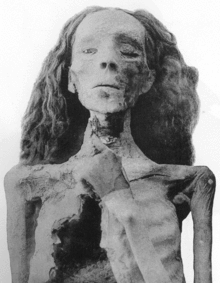
Tiye is believed to have been originally buried in the Royal Tomb at Amarna alongside her son Akhenaten and granddaughter, Meketaten. Evidence shows the two northern pillars of the incomplete pillared hall were removed to accommodate a sarcophagus plinth[17] and pieces of her smashed sarcophagus were found in and around the burial chamber.[18] Analysis of the badly damaged decoration on the left wall beyond the plinth also indicates that Tiye was buried there. In a depiction that closely resembles the mourning of Meketaten in chamber γ, a figure stands beneath a floral canopy while the royal family grieves. The figure wears a queenly sash but cannot be Nefertiti as Nefertiti is shown with the mourners.[19] Tiye's sarcophagus was likely contained within multiple nested shrines, like those of her grandson Tutankhamun. The inscription on a portion of such a shrine found in KV55 indicates that Akhenaten had the shrines made for his mother.[20]
Following the move of the capital back to Thebes, Tiye, along with others buried in the royal tomb, were transferred to the Valley of the Kings. The presence of pieces of one of her gilded burial shrines in KV55 indicate she was likely interred there for a time.[21] Provisions had been made during the reign of her husband Amenhotep III for her burial within his tomb, WV22. Shabti figures belonging to her were found in this tomb.[22]
In 1898, three sets of mummified remains were found in a side chamber of the tomb of Amenhotep II in KV35 by Victor Loret. One was an older woman and the other two were a young boy who died at around the age of ten, thought to be Webensenu or Prince Thutmose, and a younger, unknown woman. The three were found lying naked side-by-side and unidentified. The mummy of the older woman, who would later be identified as Tiye, was referred to by Egyptologists as the 'Elder Lady' while the other woman was 'The Younger Lady'. Several researchers argued that the Elder Lady was Queen Tiye. There were other scholars who were skeptical of this theory, such as British scholars Aidan Dodson and Dyan Hilton, who once stated that "it seems very unlikely that her mummy could be the so-called 'Elder Lady' in the tomb of Amenhotep II."[22]
A nest of four miniature coffins inscribed with her name and containing a lock of hair[23] was found in the tomb of her grandson, Tutankhamun— perhaps a memento from a beloved grandmother.[22] In 1976, microprobe analysis conducted on hair samples from the Elder Lady and the lock from the inscribed coffins found the two were a near perfect match, thereby identifying the Elder Lady as Tiye.[24]
By 2010, DNA analysis, sponsored by the Secretary General of the Egyptian Supreme Council of Antiquities Zahi Hawass, was able to formally identify the Elder Lady as Queen Tiye.[25] She was found to be about 40–50 years old at the time of her death, and 145 cm (4 ft 9 in) tall.[26]
In the arts
Music
- Philip Glass: opera, Akhnaten: An Opera in Three Acts (1983; CBS Records, 1987)
References
- Tyldesley 2006, p. 115.
- "Bart, Anneke. "Ancient Egypt." http://euler.slu.edu/~bart/egyptianhtml/kings%20and%20Queens/amenhotepiii.htm
- Tyldesley 2006, p. 116.
- O'Connor & Cline 1998, p. 5.
- O'Connor & Cline 1998, p. 5-6.
- Shaw, Ian. The Oxford history of Ancient Egypt. Oxford University Press: London, 2003. p.253
- Tyldesley 2006, p. 121.
- Aidan Dodson, "Amarna Sunset: Nefertiti, Tutankhamun, Ay, Horemhab and the Egyptian Counter-reformation" (Cairo: AUC Press, 2010), pp.27-29
- O'Connor & Cline 1998, p. 6.
- Kozloff, Arielle; Bryan, Betsy (1992). "Royal and Divine Statuary". Egypt's Dazzling Sun: Amenhotep III and his World. Cleveland. ISBN 978-0-940717-16-9.
- O'Connor & Cline 1998, p. 6-7.
- Tyldesley 2006, p. 118.
- "EA 26 - A Letter from Tushratta to Tiye".
- O'Connor & Cline 1998, p. 23.
- Joyce Tyldesley, Nefertiti: Egypt's Sun Queen, Penguin UK, 2005
- Reeves, Nicholas. Akhenaten: The False Prophet, pp. 75-78
- Martin, G. T. (1989). The Royal Tomb at El-'Amarna. The Rock Tombs of El-'Amarna, Part 8. Volume 2. London: Egypt Exploration Society. p. 21.
- Gabolde, M. (1998). D'Akhenaton à Toutânkhamon. Lyon: Université Lumière-Lyon. pp. 134–36.
- Dodson, Aidan (2018). Amarna sunset : Nefertiti, Tutankhamun, Ay, Horemheb, and the Egyptian counter-reformation (Revised ed.). Cairo: The American University in Cairo Press. p. 25. ISBN 978-977-416-859-8.
- Davis, T. M. (1910). The Tomb of Queen Tȋyi. Westminster: Archibald Constable.
- Dodson, Aidan (2018). Amarna sunset : Nefertiti, Tutankhamun, Ay, Horemheb, and the Egyptian counter-reformation (Revised ed.). Cairo: The American University in Cairo Press. p. 76. ISBN 978-977-416-859-8.
- Dodson & Hilton 2004, p. 157.
- 320e. "Griffith Institute: Carter Archives - 320e". www.griffith.ox.ac.uk.
- Harris, James E.; Wente, Edward F.; Cox, Charles F.; El Nawaway, Ibrahim; Kowalski, Charles J.; Storey, Arthur T.; Russell, William R.; Ponitz, Paul V.; Walker, Geoffrey F. (1978). "Mummy of the "Elder Lady" in the Tomb of Amenhotep II: Egyptian Museum Catalog Number 61070". Science. 200 (4346): 1151. Bibcode:1978Sci...200.1149H. doi:10.1126/science.349693. ISSN 0036-8075. JSTOR 1746491.
- Hawass, Zahi et al. "Ancestry and Pathology in King Tutankhamun's Family" The Journal of the American Medical Association pp.640-641
- Hawass, Zahi; Saleem, Sahar N. (2016). Scanning the Pharaohs : CT Imaging of the New Kingdom Royal Mummies. Cairo: The American University in Cairo Press. p. 77. ISBN 978-977-416-673-0.
| Wikimedia Commons has media related to Tiye. |
- Dodson, Aidan; Hilton, Dyan (2004). The Complete Royal Families of Ancient Egypt. London: Thames & Hudson. ISBN 978-0-500-05128-3.CS1 maint: ref=harv (link)
- O'Connor, David; Cline, Eric H. (1998). Amenhotep III: Perspectives on His Reign. Ann Arbor: University of Michigan Press. ISBN 978-0-472-08833-1.CS1 maint: ref=harv (link)
- Tyldesley, Joyce (2006). Chronicle of the Queens of Egypt. London: Thames & Hudson. ISBN 978-0-500-05145-0.CS1 maint: ref=harv (link)
